In April 2023, the Department for Environment, Food & Rural Affairs (Defra) published its Plan for Water. The aim of the plan is to create a more holistic approach to water management, ensuring that there is enough water to supply the UK’s growing population, and that the water in rivers, lakes and other water bodies is free from pollution. It promises action on all sources of pollution: wastewater treatment, agriculture, plastics, urban stormwater and road run-off, and chemicals.
Public awareness and concern about water quality, and how it impacts on the natural environment and on public health, is growing fast. And stormwater is increasingly being recognised as a big issue. As rainfall events become more intense, and our ageing sewer system becomes ever more overloaded, combined sewer overflows – where wastewater is discharged into rivers and other water bodies – are being activated more frequently.
New legislation will be welcome then – which is what the Government is suggesting in its Plan for Water. Among the proposed legislation are changes to planning policy so that new developments are designed to reduce the likelihood of both flooding and water shortages. Water companies, which will have to produce Drainage and Wastewater Management Plans, could be involved in planning decisions.
The Plan also references the Government’s plans to finally implement Schedule 3 of the Flood and Water Management Act 2010, which covers SuDS approval and adoption, in England – subject to consultation. Initially announced in January 2023, this could make the inclusion of SuDS standard practice in the design, construction and adoption of nearly all new developments from 2024. It also talks about the strategic road network and how it needs to do more to prevent pollution from highway run-off discharging into our water courses (see box).
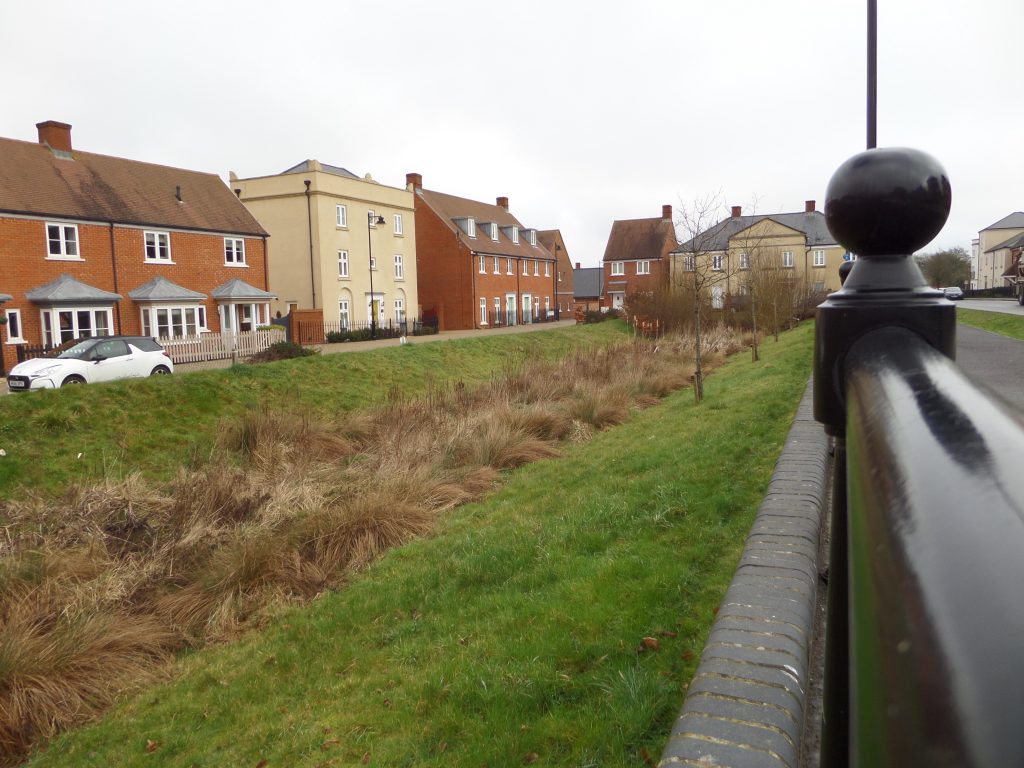
Bioswale at a development in Hampshire taken in March 2023, showing how good SuDS can be.
Multi-faceted SuDS
Well-designed SuDS can help reduce pollution in a variety of ways. SuDS should be multi-faceted, dealing with water at source to prevent activation of combined sewer overflows (CSOs) and flooding and removing pollutants to improve water quality – as well as boosting biodiversity and providing public amenity.
Good SuDS design is based on the SuDS treatment train, or SuDS management train, which sees water passing through a logical sequence of stages using different SuDS components. The treatment train should consider both water quantity and quality, with the weighting given to each dependent on predicted water volumes, flows and the levels and types of pollution.
A SuDS train should start with prevention such as reducing impermeable surfaces, to reduce run-off and removing sources of pollution. Next comes source control, where rainfall is dealt with close to where it falls by infiltration-based elements such as soakaways, rain gardens and permeable pavements. Site control sees water managed within a local area, for instance directing water to a soakaway or infiltration device and then onto an attenuation pond or tank. Finally, regional control would see a system that could handle run-off from several sites, perhaps resulting in a detention basin or wetland.
The SuDS Manual, C753, published by CIRIA, prescribes a risk-based approach to designing SuDS for water quality. If pollution risks are deemed to be low, then SuDS designers can prioritise water quantity, amenity and biodiversity. If they are medium, then all considerations must be balanced. And if they are high, water quality evaluation must take precedence, for instance on haulage yards, industrial sites, trunk roads and motorways. It should however be noted that in all cases, including medium and low pollution risk sites, appropriate mitigation should be put in place to reduce the risk of pollution.
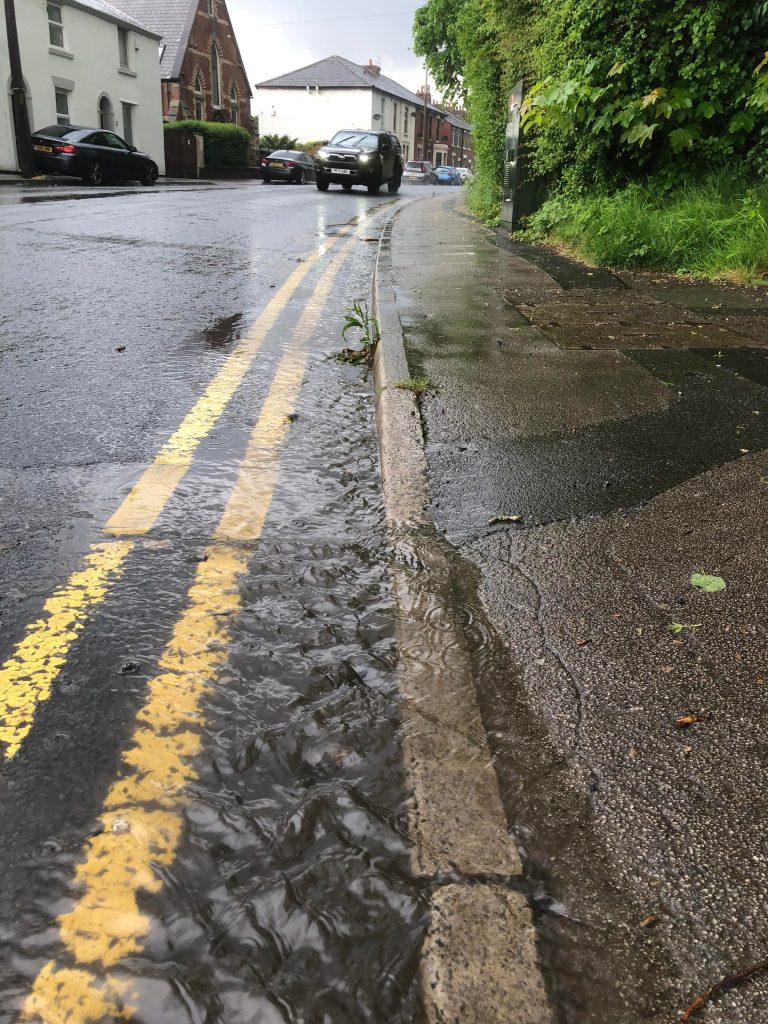
Heavy rain causing stormwater runoff from a road in Hoghton, near Preston, Lancashire in May 2022.
There are a range of water quality treatment measures that can be included in a SuDS train. Sometimes it is possible to use a completely natural SuDS train to deal with both water quantity and quality issues. At other times, the best solution combines natural and engineered SuDS elements, or may require proprietary manufactured elements only. This could be due to high levels of pollution loading or the space available.
There are four main types of pollutant that can be found in stormwater run-off: sediments, metals, hydrocarbons and nutrients. Sediments, often referred to in pollution mitigation as total suspended solids (TSS), is particulate matter. It includes tiny particles of soil, such as silt and clay, which have been dislodged by rainwater as it passes over the run-off surfaces.
Metals and metal compounds can be dissolved in run-off or attached to silts and sediments in the water. Copper and zinc are most commonly found in surface water in the UK but there can be cadmium and other toxic metals too. Although plants require very small amounts of copper and zinc to grow, higher concentrations can be damaging to them.
Hydrocarbon pollution comes with run- off from roads, car parks and areas where machines operate and are maintained, due to oil and fuel spills, tyre and brake wear. Changing climate means that rainfall events can be further apart but more intense, which can lead to higher concentrations of pollutants from roads, as they build up for longer before being washed away. Nutrient pollution, usually nitrogen or phosphorous based, can come from sources such as run-off from agricultural land where fertiliser has been used or CSOs, where waste water and surface water are discharged into bodies of water. They can lead to algal blooms, which reduces oxygen and can negatively impact on aquatic habitats. The Plan for Water reports £2.5bn of planned and made investment in wastewater treatment works between 2020 and 2025, which it says will halve phosphorous pollution. And it promises legislation to force water companies to make upgrades to nutrient removal near protected habitats. The Government’s Environment Act 2021 set a legally binding target to reduce phosphorus in treated wastewater by 80% by 2038 compared to a 2020 baseline, with an interim target of 50% by 2028.
Recent studies carried out by Stormwater Shepherds have indicated that phosphorus pollution is not a major problem from most urban surfaces. However, well designed SuDS can help alleviate nutrient pollution where it is a problem in surface water run-off. CIRIA guide C808, Using SuDS to reduce phosphorous in surface water run-off, published in 2022, provides guidance on how to do this. It suggests a treatment train starting by maximising infiltration, followed by sedimentation and the removal of solids and finally the introduction of actively growing plants to take up some of the dissolved phosphorus.
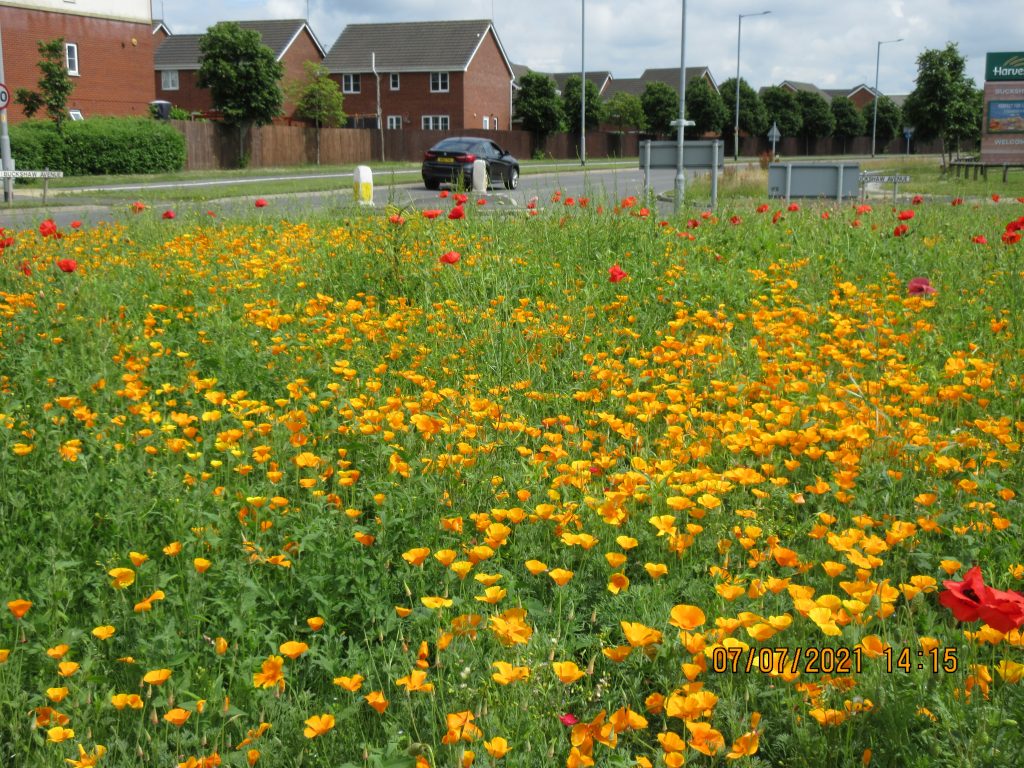
Wildflowers in a SuDS scheme in Chorley in Lancashire.
Capturing TSS pollution should generally be the focus of water treatment strategies in SuDS design since this removes both the solid particles and any pollution clinging to them. This can be done using a natural SuDS feature, such as planting for bioretention or a swale. Manufactured components such as filtration devices, silt traps or vortex separators can also be used upstream to remove solids before water is discharged into ponds, for instance.
Removal of sediment and solids is also important from a water quantity perspective. Build-ups reduce the capacity of a water storage element, whether natural or manufactured. How and when to remove sediment should be considered at the design stage and should be part of a planned maintenance regime.
Without a means of reducing suspended solids upstream of an attenuation device, sediment build-up within the device can reduce its efficiency over time. Some recently Introduced underground SuDS
attenuation devices have their own built-in systems for intercepting solids which are fast and simple to maintain.
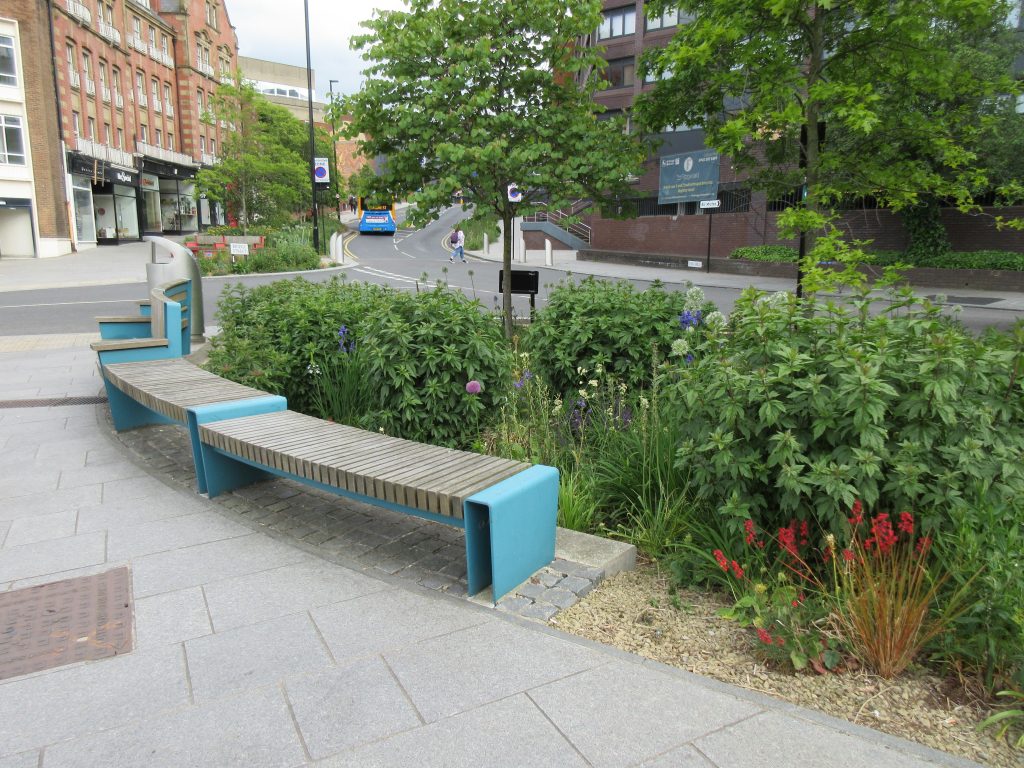
SuDS in the Sheffield Grey-to-Green scheme, photographed in May 2022.
Mitigation Indices
The SuDS Manual sets out a simple method for dealing with water pollution risks, requiring the determination of pollution hazard indices for the area under consideration and then matching a SuDS device with matching mitigation Indices.
In Table 26.2, the manual provides pollution hazard indices for a range of land uses and for three types of pollution: TSS, metals and hydrocarbons. So, for example, for a busy public car park such as a supermarket or hospital, the index for TSS is 0.7, for metals is 0.6 and for hydrocarbons 0.7.
The next step is to identify a form of SuDS treatment that can provide the necessary mitigation indices, either as a single treatment stage or using a combination of components. The manual has a table for that too, Table 26.3. However, this table only provides indices for natural SuDS components, stating that proprietary treatment systems must demonstrate that they can address each of the contaminant types to acceptable levels.
The mitigation indices for the natural SuDS components were compiled by a team of experts, drawing information from a selection of published papers. More recently, in 2016, British Water published a Code of Practice for the Assessment of Manufactured Treatment Devices Designed to Treat Surface Run- off. It combines the rainfall time-series data for the UK to determine an appropriate treatment flow rate based on first-flush principles and uses a combination of two test protocols – the German Deutsches Institut für Bautechnik (DIBt) and the New Jersey Comprehensive Assessment Tool (NJCAT) from the US – to create the British Water test methods.
In 2022 British Water has also published a How To Guide, Applying The CIRIA SuDS Manual (C753) Simple Index Approach To Proprietary/Manufactured Stormwater Treatment Devices, which provides a calculation methodology to derive mitigation indices for TSS, metals and hydrocarbons based on the Code of Practice, or the DIBt or the NJCAT, test results. This allows manufactured treatment products to have their mitigation indices published so that they can be considered as part of a SuDS Management Train, often alongside vegetative treatment components.
The value of water quality
One of the challenges in the delivery of well-designed SuDS treatment trains is that important elements of the train can be removed during ‘value engineering’ exercises. For instance, a design or specification may include guidance to say that sediment should be removed upstream, but this is then considered unnecessary during a ‘value engineering’ exercise and removed or compromised.
Unfortunately, decisions like this are about short-term capital cost rather than whole life cost. They don’t consider the important issues of how maintenance should be carried out, its frequency and its cost – in terms of both cash and carbon. It may also result in failure of the system to continuously provide the required performance according to the original design, throughout the life of the development. Should Schedule 3 of the Flood and Water Management Act come into legislation, maintenance and longevity issues will be brought to the fore. In Wales, where Schedule 3 has already been adopted, developers are expected to create a maintenance plan and the adopting authority will be required to carry out the maintenance for the design life of a scheme.
SABS within county and unitary authorities will be responsible for securing the means to maintain the SuDS they adopt, and it could be that the regulatory framework in England is similar to that used in Wales. As currently understood, funding will be provided by the developer in the form of a commuted sum to the SuDS Approval Body (SAB) at the point of handover. The timeframe for the enactment of Schedule 3, and the many other pieces of proposed legislation for the Plan for Water, remains uncertain – not least due to the uncertainty over when the next general election will be held. However, the urgent need to address water quality issues will only move up the political agenda.
Incorporating SuDS trains that manage both water quality and quantity into new developments does not necessarily have to increase capital costs. Good design can reduce costs over the lifetime of the SuDS and the development.
Highway run-off
Pollution due to road run-off is a major problem in the UK. There are estimated to be over one million drains and outfalls from the strategic road network and local authority roads, the majority of which run straight into rivers and other water courses with no measures to treat the pollution in the water before they do.
The result of this is a build-up of toxic pollution in riverbeds, water, fish and other aquatic life. Run-off from roads contains high amounts of suspended solids which sit on the bed of a watercourse, bringing with them other pollutants which are released over time. Pollutants include polycyclic aromatic hydrocarbons (PAH), metals and microplastics from brakes and tyres.
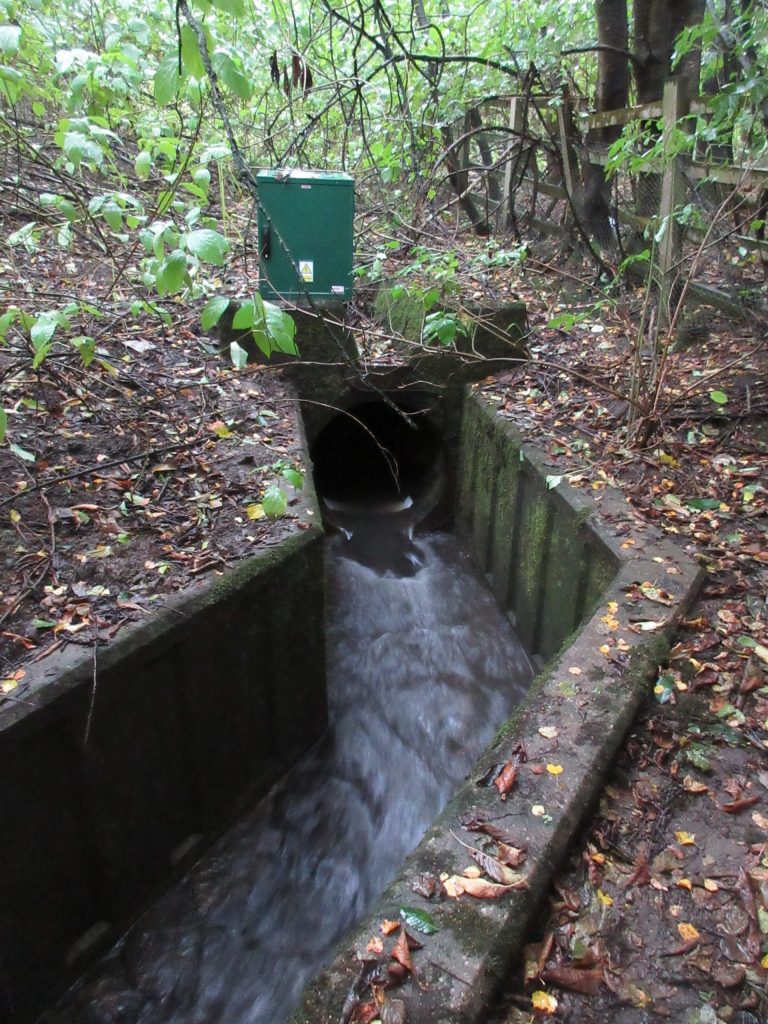
Only 4,000 out of 26,000 outfalls and soakaways from the Strategic Road Network, run by National Highways in England, have measures in place to treat pollution. The Environmental Permitting Regulations say that highways authorities can discharge road-run off into water bodies only if it doesn’t cause pollution. However, the Environment Agency has never required a road authority to apply for a permit where polluted road run-off is discharging straight into rivers and other water bodies.
The Plan for Water does mention this issue, but there is no firm plan for action when it comes to road run-off. Instead, it says that it is “considering actions to take to reduce the impacts of the Strategic Road Network on water quality as part of developing the next Road Investment Strategy.” The Government will also consider ‘targeted action’ for roads owned by local authorities whose road run-off is contributing to pollution. This falls short of the urgent action which the House of Commons Environmental Audit Committee (EAC) called for in its Water Quality in Rivers report, published in January 2022. One of its suggestions was that the Environment Agency should require discharge permits for any road with annual average daily traffic above 15,000 vehicles.
National Highways has a target of improving 17.5km of water bodies every year.
The plan reports that to date National Highways has delivered over 30 water quality initiatives which have improved just under 20 miles (32km) of water bodies. In 2020-21, its annual report said it had improved 17km of waterbody, so it appears to be missing its targets. There are a number of ways that run-off from roads can be treated for pollution before it enters a water body. SuDS can be used as part of the water treatment train.

Stuart Crisp is UK Manager for Advanced Drainage Systems (ADS). ADS is America’s largest manufacturer of thermoplastic corrugated drainage pipes and a specialist in water management systems. StormTech has a long and successful track record with over 50,000 below ground SuDS attenuation system installations using in excess of 3m units.
Originally published in Drain Trader magazine June 2023
For more information on Advanced Drainage Systems, visit www.adspipe.co.uk.